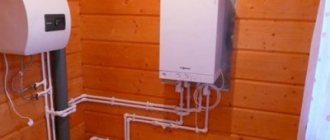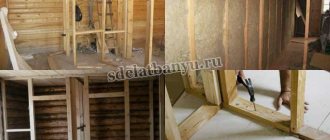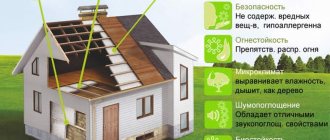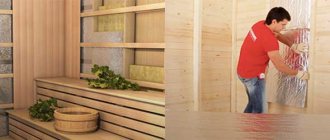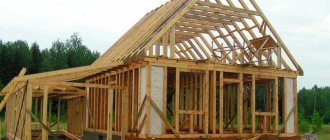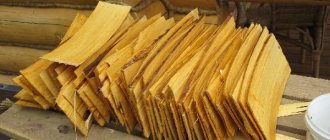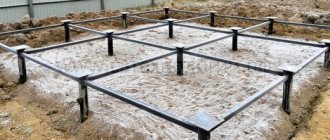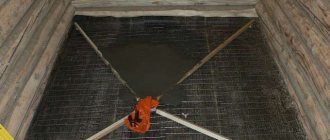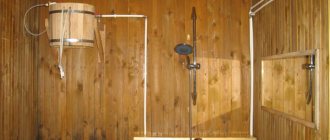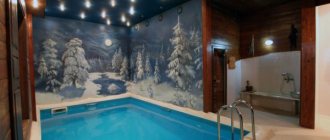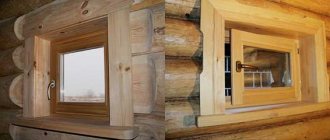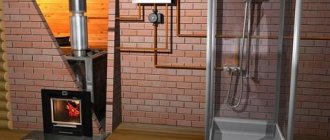To accumulate heat and maintain optimal temperature conditions in the steam room, modern insulation materials are used. However, the main disadvantage of such materials is their high moisture absorption, which leads to a decrease in thermal insulation properties and the gradual destruction of the wooden structure.
An effective way to solve this problem is a vapor barrier in a bathhouse, which will provide reliable protection for insulating materials.
Why is vapor barrier necessary?
Currently, most bathhouses have interior walls lined - this is beautiful, useful and prestigious. The walls are usually covered with natural clapboard. From the designer’s point of view, everything is great, but from the builder’s point of view, there are big problems.
- An additional “heat-protective” wall is formed between the load-bearing wall and the steam room. This is good, it minimizes heat losses, but it causes condensation.
- Due to the low thermal conductivity of wood, the temperature difference between the lining and the wall is large. This situation needs to be looked at from two sides. The good thing is that the steam room retains heat. The bad thing is that steam easily passes into the forcing joints, and the relative humidity of the wood increases.
Diagram of the construction of bathhouse walls with vapor barrier
Diagram of the installation of brick walls of a bathhouse with vapor barrier
Now we come to the main problem. If the temperature of the lining is so high that condensation does not form given the existing humidity, then the wall temperature is below the dew point. Condensation forms on cold walls and is absorbed into all materials of external walls: wood blocks, brick. Due to the fact that natural ventilation between the sheathing and the wall is almost completely absent, water does not evaporate. As a result, the wood begins to rot, the red brick crumbles, and the concrete materials transfer moisture through micropores to all adjacent structures.
Dew point table
Dew point in the wall
Here you can clearly see how the dew point in the wall of the house will shift
Prices for vapor barrier
vapor barrier film Yutafol
What is dew point
In order to effectively combat a harmful phenomenon, you need to know and thoroughly understand its nature.
In ancient times, when a bathhouse was simply and unpretentiously built entirely from logs, the problem of dealing with condensation did not exist at all. The internal space warmed up evenly and stably and gave up a considerable part of its thermal energy to the inner surface of the wall of the steam room, which also heated up to significant temperatures. This circumstance completely excluded the possibility of condensation even at 100% relative humidity of the internal environment of the bath. In addition, the material of the walls itself implied active gas exchange both on the surface and on the internal solid wood. And finally, the wooden log was open, freely washed by air, both outside and inside the room. In general, almost ideal conditions for blocking moisture condensation.
In modern times, a lot has changed. Often the load-bearing walls of a bathhouse are made of stone, brick, and have a multi-layer frame structure in which the wooden interior is replaced by a stone exterior. It is in such conditions that dew falls, but not the morning dew that excited the lyrical souls of poets, but another, the kind that wears away the stone drop by drop.
Science defines the concept of dew point as the temperature to which the air must cool, so that the water vapor contained in it reaches the saturation threshold and the process of condensation and dew begins.
For clarity, we support scientific phrases with a simple table:
| Ambient air temperature, degrees Celsius | Dew point temperature, at 30% relative humidity | Dew point temperature, at 40% relative humidity | Dew point temperature, at 50% relative humidity | Dew point temperature, at 60% relative humidity | Dew point temperature, at 70% relative humidity | Dew point temperature, at 80% relative humidity | Dew point temperature, at 90% relative humidity |
| 20 | 1,9 | 6 | 9,3 | 12 | 14,4 | 16,4 | 18,3 |
| 25 | 6,2 | 10,5 | 13,9 | 16,7 | 19,1 | 21,3 | 23,1 |
| 30 | 10,5 | 14,9 | 18,4 | 21,4 | 23,9 | 26,2 | 28,2 |
In general, the rhetoric is simple. Either you have a completely energy-inefficient room and forget about condensation as such, but heat and heat your bathhouse, or you have excellent thermal insulation, save enormously on heating, but remember that the vapor barrier in the bathhouse was created just for you. At current fuel prices, it is better to invest once in a vapor barrier than to constantly invest, if not in fuel, then in major repairs of the premises.
Vapor barrier and wall insulation
But these are not all the reasons why you should use a vapor barrier. Let's touch on the issue of insulating the bathhouse. Insulating the outside is a waste of money and time. Until the insulation “shows its effectiveness,” no one will wash in the bathhouse. The heating time for the sheathing and walls is several hours. Only then will the internal heat “reach” the insulation outside the external walls and it will be able to “work”. The effect will no longer be during the heating of the steam room, but during its cooling after washing. To “enjoy” the effectiveness of external thermal insulation, you need to stay overnight in the steam room.
It is necessary to insulate the bathhouse from the inside
This means that for steam rooms, insulation needs to be installed only inside. But here too a problem arises. Most often, mineral wool, glass wool or polystyrene foam are used as insulation. The latter is not environmentally friendly and emits harmful chemical compounds, especially during heating. Sanitary authorities categorically do not recommend using it for steam rooms. What remains is mineral wool or glass wool.
Mineral wool insulation
Mineral wool as insulation
Mineral wool has two “unpleasant” properties. First, with increasing relative humidity, thermal conductivity characteristics decrease significantly. This is what some “experts” write, although the characteristics increase, thermal conductivity increases, and heat saving decreases. Do you feel the difference? Three times - cotton wool takes a very long time to dry, there is almost no air movement in it. Which is natural, otherwise the heat would not be retained in the room. Insulation is always attached to the walls, regardless of the material they are made of. And prolonged contact with wet wool has an extremely negative effect on all building materials. Here is another reason why you need to use a vapor barrier in a bathhouse.
Condensation on mineral wool laid without a vapor barrier
Mineral wool absorbs condensation and moisture
If you understand these issues, you can familiarize yourself with various vapor barrier materials and their physical characteristics.
Prices for mineral wool
mineral wool
The principle of heat retention for a bath ceiling
The bathhouse can be classified as a building with special operating conditions. Due to the fact that this is most often an unheated room, with occasional heating of air masses to high temperatures and a large amount of steam, the ceiling, which absorbs maximum temperature influences, can quickly become unusable.
Depending on the budget and capabilities of the owner, the bathhouse can be a whole complex of several rooms for undressing and relaxation and a steam room itself, or a small building with a steam room and a dressing room. Regardless of the area, the ceiling must be properly insulated with a mandatory vapor barrier device.
The most common method of producing steam for a Russian bath is the construction of a heater stove. A large amount of steam released due to temperature changes and excess humidity will settle in the form of condensation on the ceiling lining, up to the formation of large drops that fall down. An unsuccessful vapor barrier in a wooden house will lead to soaking of the insulation, loss of its qualities, and ultimately to excessive fuel consumption and an uncomfortable stay in the steam room.
Due to the design features of the roof, log baths or baths made of timber can be divided into two types: with and without an overhead “attic” space.
Depending on this, the vapor barrier device will be designed differently.
Types and characteristics of vapor barrier materials
There are quite a few of them; we will focus only on a few of the most frequently used ones. Let's start again with a little “educational education”. Some amateur builders do not fully understand the difference between vapor barrier and waterproofing materials. After all, steam is the same as water. Why should some materials be used for vapor barrier and others for waterproofing?
Vapor barrier and waterproofing. Differences and Similarities
The fact is that water molecules and steam molecules have different sizes. Based on these characteristics, manufacturers produce materials with different micropore diameters. Some do not allow steam molecules to pass through (vapor barrier), while others do not allow water molecules to pass through. This means that vapor barrier materials can also be used as waterproofing, but the latter cannot be used in the same way. Recently, the production of vapor-waterproofing fabrics has begun; they consist of two layers with different micropore diameters. When installing such materials, you need to monitor the location of these sides so as not to install “exactly the opposite.”
Anti-condensation multilayer vapor barrier “Brane D Super” Tyvek Solid is a single-layer waterproofing material with high vapor permeability that protects against precipitation and wind
ISOSPAN FX reflective heat-hydro-vapor barrier
Izospan RS
Izospan fx
Prices for Izospan
Izospan
What vapor barrier materials are produced?
| Material | Description |
Ordinary polyethylene film. | The cheapest, but pretty good option. It has another significant advantage. The films are produced in sleeves with double walls, the sleeve width is up to three meters. By cutting the sleeve in half, you get a sheet of continuous film more than five meters wide - quite enough to cover the wall of a bathhouse with a continuous material without overlays. |
Glassine, roofing felt and other bituminous materials. | They are rarely used in baths due to the likelihood of unpleasant odors. |
Pure aluminum foil and aluminum coated multi-component materials. | Used most often, multi-component materials have a small layer of thermal protection or special fibers to prevent condensation from draining. |
| Liquid rubber. | An excellent vapor barrier material that can be applied to surfaces of any complexity and configuration. |
| Liquid polyurethane foam insulation. | In addition to their main tasks of insulation, they have a sealed outer surface that does not allow steam to pass through. Universally applicable, characterized by high performance characteristics. |
Traditional materials: clay, straw, sawdust
Now they are all practically replaced by polymer and mineral insulation. They are produced in a wide range of different compositions, purposes and prices. The use of traditional materials for floor insulation is justified only in a few cases:
- very limited budget for the construction of a bathhouse;
- availability of material at a low price or free of charge (for example, receiving sawdust from a timber processing plant);
- special requirements for the safety and environmental friendliness of materials for the entire bath.
The clay-straw mixture is laid in the same way as ordinary expanded clay. Based on natural materials, many heat-insulating compositions can be created, for example, sawdust concrete, clay concrete, adobe. They are used in accordance with building regulations.
Important! All organic materials are not resistant to water and are short-lived. This is the main thing to consider when using them.
Some general tips for laying vapor barrier materials in a bathhouse
You can find advice from “experts” who encourage making small holes in vapor barrier materials through which air will pass, and the structure supposedly will not suffer from high humidity. There is nothing to say, it is better to remain silent. When installing a vapor barrier, the main condition for effectiveness is the complete absence of gaps ; overlapping materials must be sealed with ordinary tape (cheaper option) or special metallized tape (more expensive option). The presence of any cracks nullifies all activities.
Laying the material strictly without gaps
The fewer holes the material has during fixation, the better the protection. If possible, try to use double-sided tape or silicone glue. Of course, the choice of adhesive composition must correspond to the physical characteristics of the vapor barrier material. Now we will consider two options for performing the work: for a bathhouse with brick walls and for a ceiling.
Wall vapor barrier Izospan V is laid on the inside of the insulation with the smooth side facing it
Izospan SL - special tape for fixing steam and waterproof membranes
Connection of canvases
Waterproofing in the sauna
In saunas, the most popular are porcelain stoneware floors on a concrete screed. Waterproofing is carried out by spreading rolled material between the screeds. At the same time, it must separate the thermal insulation layer from the penetration of water through the floor. If you plan to heat the floor, you need to check the characteristics of the waterproofing material for the maximum heating temperature.
There should be no foreign odors in the room.
The waterproofing of the floor in the steam room and sauna must have the necessary heat resistance.
Many bitumen resins begin to significantly lose strength only at temperatures above 100 degrees.
Thermal decomposition with the release of harmful components begins only at 250-300 degrees.
So, such materials are quite suitable for baths and saunas.
Warm floors based on film heaters emit IR heat rays only upward. The maximum heating temperature for them is about 40 C.
In this case, the requirements for the heat resistance of the waterproofing material are much lower. Hydroisol has a heat resistance of about 90 C.
Vapor barrier for brick walls
Such baths are very rare and belong to elite and expensive buildings. Their vapor barrier is quite complex, in most cases two-layer. Brick baths must have insulation on the walls, and it is highly desirable on the interior. We have already explained why this is so.
Brick wall insulation scheme
Step 1. Selection and calculation of the quantity of materials. The quantity is easy to calculate: measure the quadrature of all surfaces and increase the resulting number by ten percent. It is more difficult with the selection of materials. As we have already noted, only materials that are safe for health can be used for thermal insulation of indoor baths. Not “environmentally friendly”, as it is now fashionable to say, but safe.
Environmentally friendly are materials that do not harm the environment (clay, sand, etc.), and during the production of all artificial materials, harm to the environment is caused. This means that mineral wool is a material that is safe for health, but it cannot be called environmentally friendly. We will focus on mineral wool; we will use composite foil as a vapor barrier material.
Penofol foiled with Aluf
Reflective insulation from Penotherm
Step 2 . Surface preparation. Mineral wool must be protected on two sides: on the wall side from condensation moisture and on the bath side from steam. Carefully inspect the wall surface, remove all sharp protrusions. The fact is that most vapor barrier materials are not very durable; sharp protrusions can damage them, and this will significantly reduce their effectiveness.
Step 3 . Attach a layer of waterproofing to the wall, which will prevent the mineral wool from absorbing water from the relatively cold brickwork. You can use any cheap materials, the best option is liquid rubber. When attaching insulation, try to make do with a minimum number of holes in the material. If you use roll coverings, they are fixed with wooden slats, between which mineral wool will be laid. The width of the slats should correspond to the thickness of the mineral wool, the distance between them is approximately 40÷50 centimeters.
Waterproofing with liquid rubber
Waterproofing of brickwork by injection of microcements and methacrylate gels
Penetrating waterproofing
Step 4 . Place mineral wool in the free space between the slats and the wall, making sure there are no gaps. To ensure natural ventilation, a gap must be made between the insulation and the sheathing.
Insulation of walls with mineral wool
Step 5. For vapor barrier, we recommend using a composite material: aluminum film coated with polyurethane foam. It is stronger than ordinary aluminum film and has, albeit small, insulation. This material can be bent at different angles and can withstand fairly high tensile forces. In addition, a thin insulating layer seals the holes from the fastening hardware.
Vapor barrier with foil
Step 6. Carefully unwind the vapor barrier roll and nail it to the slats with thin strips. In this case, the planks need to be drowned a little in mineral wool - there will be a gap between your “pie” and the upholstery paneling.
Step 7 . Seal the joints of the vapor barrier material. To do this, you can take tape, metallic tape, or use silicone glue.
Vapor barrier for brick walls
Now you can start covering the walls with natural clapboard.
Prices for liquid rubber
liquid rubber
Video - What will happen when installing vapor barriers?
Waterproofing
Waterproofing was previously carried out using roofing felt and bitumen. Now dozens of more advanced materials have been proposed for it. Particularly noteworthy are materials that were specifically designed for use in baths and for waterproofing residential buildings, for example, waterproofing.
Information. Both roll material and mastic are produced under this trade name. It's best to use both options. First, the rolls are laid out, and all seams and joints are sealed with mastic.
The advantage lies with composite waterproofing materials. They contain reinforcing fiber, wood, cardboard, or fiberglass, resin, which does not allow moisture to pass through, and outer protective layers, such as film.
Film-based waterproofing materials are the cheapest, but they are of limited suitability for bathhouses due to their low strength. They are used as auxiliary.
The first stage is waterproofing the foundation. The floor is insulated secondarily. The third requires hydro and vapor barrier of walls, ceiling and under-roof space.
Waterproofing the floor in the bathhouse is carried out using rolled materials with seam treatment.
In terms of water resistance, this is a very reliable option.
This scheme is even used to create roofs where the action of water is much more intense than on the floor of a bathhouse.
Gidroizol is a rolled material on a high-strength fiberglass base.
It is used in construction for waterproofing in the most critical cases: swimming pools, habitable roofs, baths and saunas. In structure, it is similar to the previously widely used roofing felt, but instead of a cardboard base, it uses fiberglass.
The application technology is absolutely the same and extremely simple. The roll is rolled out, leveled, and all seams are carefully coated with special resin.
The finished coating does not have high mechanical strength, so it is necessary to provide good external protection.
General rules for the use of waterproofing and other rolled materials:
- The base must be smooth, without sharp corners and edges;
- Only one material should be used for one coating;
- All seams and joints are carefully coated with mastic;
- Surfaces must be cleaned of dust and any loose particles;
- The external protection of the waterproofing layer must completely cover it.
A concrete screed is applied over the waterproofing layer. Many rolled materials have a mineral coating. It improves adhesion to the screed. Typically, mineral coating is applied on one side. When laying the roll, it is placed upward (front side).
Important! All insulation layers must be located below the waterproofing layer. This will ensure their safety from the action of moisture penetrating into the floor.
Ceiling vapor barrier
Ceiling vapor barrier
Initial data: the ceiling is covered with clapboard, pressed mineral wool was chosen as a thermal insulation material. It is these materials that can guarantee the expected effect from the work performed.
Step 1: Nail the rough ceiling to the ceiling joists. You can use not only edged boards; the gaps do not affect the quality. The main thing is that they are relatively smooth and do not have protruding sharp elements. If any are found, the boards must be cleaned with sandpaper. The thickness of the boards is within 20 mm.
Laying the rough ceiling
Rough ceiling
Step 2. Prepare even and smooth slats approximately five centimeters wide and two centimeters thick, to which the finishing lining of the ceiling will be attached.
Step 3. Carefully spread the foil on the ceiling; this work cannot be done alone; there is a high probability of tearing the material. In terms of strength, foil does not have high performance. Do not stretch the film too much, but do not allow it to sag more than two centimeters.
Vapor barrier
Step 4 . When nailing the planks, be very careful, immediately estimate the location of their installation and do not “fidget” on the film several times.
Step 5 . The planks are secured, start covering the ceiling with clapboard. Fix the ceiling plinths in the corners.
The photo shows the slats and the lining attached to them
DIY clapboard ceiling. The gap between the lining and the wall is up to 2 cm
Flange ceiling
The interior work is completed, go up to the attic to insulate the ceiling. We recommend using mineral wool, but in principle you can use any materials: from foam plastic to expanded clay. Mineral wool has the highest heat-saving characteristics, the optimal thickness is 10 centimeters. Place the cotton wool tightly, without gaps. The sheets are perfectly cut to existing sizes, and unproductive waste is close to zero.
Ceiling insulation with mineral wool
Mistakes when laying mineral wool
How to insulate a mineral wool ceiling
Nail boards on top of the ceiling beams. The thickness and quality of the boards depends on how you will use the attic space in the future. Although our advice is, regardless of “today’s plans,” lay the flooring with high-quality material. The boards must be edged, with a thickness of at least 25 mm, the installation process is no different from the process of laying floorboards. Press them with special or homemade clamps, do not allow cracks or curvature to appear. For fixation, you can use nails or self-tapping screws, the length of the nails is at least 70 mm.
Vapor barrier of bathhouse ceiling with foil
Waterproofing in a washing bath
Of all the bath rooms, it is in the washing room that the floor is exposed to the most intense action of water.
The necessary reliability of waterproofing can be achieved using classical technology with roll insulation and mastics.
Liquid and roll waterproofing are ideal here. If it is necessary to waterproof wood, you need to keep in mind that it changes quite significantly in size when it swells and dries.
Here, either rolled waterproofing with reinforcing fiber or liquid special grades with a high stretch coefficient of the finished coating are suitable.
Attention! When working with waterproofing materials, you must use personal protective equipment: gloves, respirators, safety glasses.
Vapor barrier for frame baths
One of the advantages of a frame bath is the lightness of the structure and the minimum amount of lumber. This same advantage also carries with it the main danger - the risk of destruction of the bathhouse increases due to the loss of load-bearing capacity by one of the structural elements. If for a log house the loss of the original characteristics of one of the beams goes unnoticed, then for this type of bathhouse the consequences of the loss of load-bearing characteristics by one of the structural elements can be very sad.
Construction of frame bath walls
The frames are made of boards 50×150 mm or 50×200 mm; all frame elements must withstand significant static loads for a long period of time. To insulate frame baths, only mineral wool is used, and it quickly absorbs excess moisture and takes a long time to dry. Contact of wooden structures with wet mineral wool leads to the appearance of fungal diseases or rot. The conclusion is simple - very great attention must be paid to the methods and methods of vapor barrier of frame baths, all technological construction operations must be carried out with the utmost care. Let's give some practical tips on protecting wooden bathhouse structures.
- Use only high-quality materials. For insulation, it is better to use foil-coated rolled mineral wool; the side with the foil should be facing toward the interior.
- Before covering the interior walls, additional vapor barrier material should be nailed. We wrote about their characteristics above. We recommend using the highest quality of them – composite foil.
How is vapor barrier done?
Step 1. Carefully fill the finished frame structures with rolled aluminized mineral wool. Frame walls have a large number of different supports; the wool needs to be cut with a small margin in size. The material is cut with a special knife.
Foil mineral wool
Using foil thermal insulation
Step 2. The foil side of the insulation should “look” into the room.
Laying mineral wool with foil inside the steam room
Step 3. Check the quality of the insulation installation; if a defect is found, eliminate it.
Step 4. Cut the vapor barrier to the width of the room if you used regular mineral wool without foil. It is better to take aluminum foil coated on one side with polyurethane foam.
Foil vapor barrier
Step 5 . You need to start installing the protective layer from the bottom up (and not vice versa!), even if condensation appears, the water will roll down like on the roof of a roof, the mineral wool will remain dry.
Step 6 . To attach the insulating layer, grab it with a stapler to the structures of the frame bath.
Step 7. Nail 20÷50 mm slats to the vertical supports of the walls; the sheathing will be attached to them in the future.
Step 8. Carefully seal the joints of the vapor barrier material with ordinary or special tape.
Sealing joints
Vapor barrier for frame bath
That's it, the vapor barrier is installed, you can start covering the internal walls. On the outside, a vapor barrier is not needed, but it is advisable to do waterproofing.
Video - Vapor barrier of a frame bath
Features of the technology
To perform vapor barrier, simple technology is used. To make a ceiling vapor-tight, you must adhere to a certain scheme. On the rough boards you need to attach a roll of waterproofing (polyethylene film) or a special water barrier, which can be fastened with an ordinary stapler. The insulation is laid as a second layer. Its tasks are as follows:
- minimize steam leakage through ceiling cracks;
- cause heat to move from cool objects to warm ones gradually;
- minimize the impact of outside air on indoor temperature.
It is difficult for one insulation to cope with the functions assigned to it. Absolutely all brands of material are negatively resistant to moisture. This also applies to the most used option - mineral wool.
No material can compare with the latter in terms of thermal conductivity. But if water constantly gets on it, over time it becomes lumpy and stops performing its intended functions.
An important point is to protect the insulation from getting wet from the outside and inside. This task will be performed by a vapor barrier, which does not allow hot steam rising to the ceiling to moisten the insulation. To do this, for example, the same foil is attached to the top of the material.
